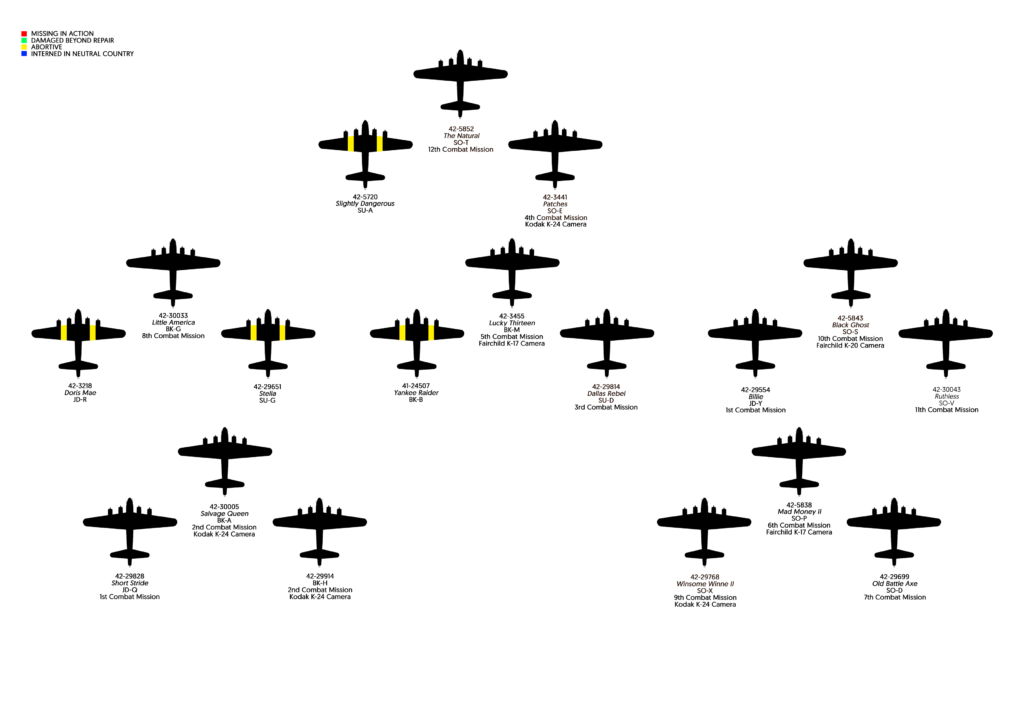77 years ago today, Lucky Thirteen flew her fifth combat mission.
Before beginning, it should be noted that Lucky Thirteen participated in a recall on 30 August 1943. Taking off at 4:55 pm, the 1BW was recalled from a strike against the airfield of Bapaume-Grévillers due to bad weather. They returned with their loads between 6:36 and 7:05 pm.
31 August 1943
VIII BC No. 88
Ramrod S. 17
384BG No. 19
The US 8AF launches 319 Boeing B-17s, escorted by 180 Republic P-47s, against the airfield of Romilly-sur-Seine, France. Additional escort is provided by RAF 11 Group. The 384BG launches eighteen aircraft this day, led by CS 41BW COL Budd J. Peaslee aboard The Natural (42-5852). Lucky Thirteen leads the second element of the lead squadron.
This strike sees the first use of VHF communications in assigning a target of opportunity. Prior to this day, the US air operations strictly enforced radio silence, particularly in regard to targets and rendezvous points. This was contested by CG 101BW (P) BG William M. Gross, who argued that, since US forces were constantly being tracked by radar, radio silence did more harm than good. Upon finding the Romilly-sur-Seine airfield obscured by clouds, Gross – who was leading the 1BW – ordered that the airfield at Amiens be bombed instead. Using VHF radio, Gross communicated the new IP, directions for the attack, and where the wing would reform afterward.
This move proves wise as the 4BW, following behind the 1BW, aborts the mission altogether.
Due to a VHF failure, neither the 306BG or the 384BG drop any bombs this day, though they do receive mission credit. Lucky Thirteen is among the bombers who report a “noisy VHF.”
The numbers:
| Bombers Launched: | 319 |
| Bombers Effective: | 106 |
| Fighters Launched: | 160 |
| Bombers MIA: | 3 |
| Bombers DBR: | 1 |
| Bombers Abort: | 213 |
| Fighters MIA: | 2 |
| Abort Rate: | 67% |
| Loss Rate: | 1% |
*Please note that the numbers above come from official US and German sources as victory claims cannot be relied upon. The numbers above do not account for RAF statistics.
No Luftwaffe interceptors are shot down this day.
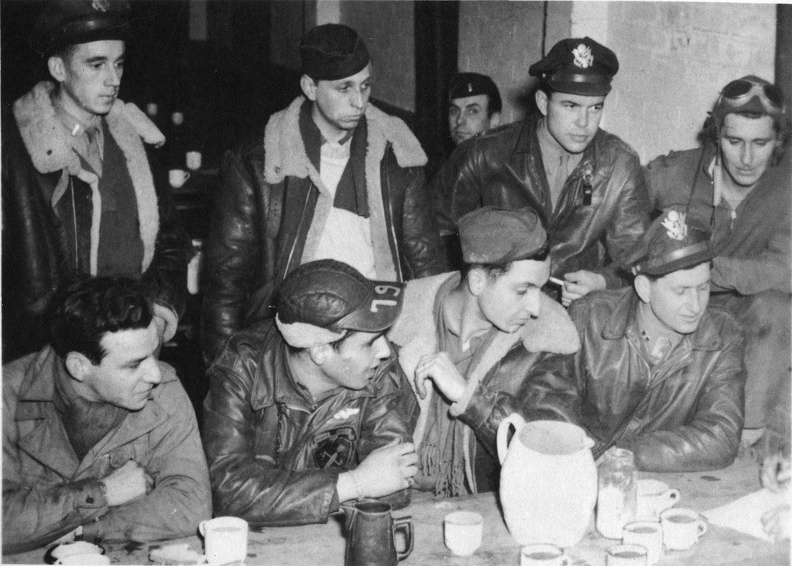
The 384BG’s lead crew from the 31 August 1943 strike – which led the entire 41BW – at interrogation. This photo was not dated.
From left to right.
(Back row)
1LT Kermit A. Pierce
SSGT George T. Redding
1LT Pendleton G. Baldwin
SSGT Rudoph Aune
(Front row)
TSSGT Dean W. Marshall
SSGT Abraham B. Abramowitz
TSGT Clarence D. Anderson
CPT Alfred L. Sprague
This crew was the first in the 544BS to complete a combat tour of 25 missions, doing so on 4 January 1944.
The 384BG’s formation chart from this day. This formation is very similar to the previous day’s recall, with Lucky Thirteen flying in the same position.
Four aircraft abort: Slightly Dangerous (42-5720) due to a broken tail wheel pin, Doris Mae (42-3218) due to all engines but No. 1 running rough, Stella (42-29651) due to an inability to keep up, and Yankee Raider (41-24507) due to low oil pressure in her No. 3 engine and a rough No. 1.
Little America (42-30033) also aborts due to a structural failure of her No. 1 turbocharger but is still given mission credit.
The Natural (42-5852) was not the intended lead bomber. Another aircraft, not identified in the records, had actually been chosen but blew its tail wheel during taxi.
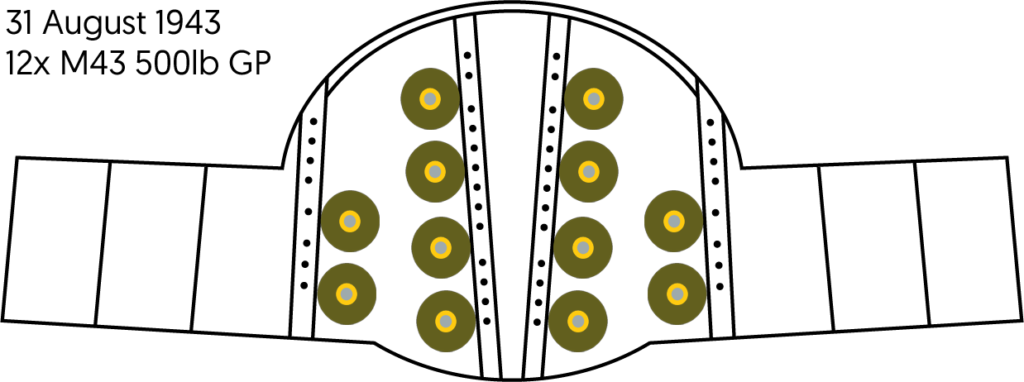
Lucky Thirteen‘s bombload for 31 August 1943.
The AN-M43 500 lb GP bomb was the most common bomb carried by US heavy bombers in the Second World War.
The previous day’s recall saw Lucky Thirteen carry 24 M81 260 lb fragmentation bombs. The M81 appeared very similar to a standard GP bomb except for a series of grooves visible on the outer shell.
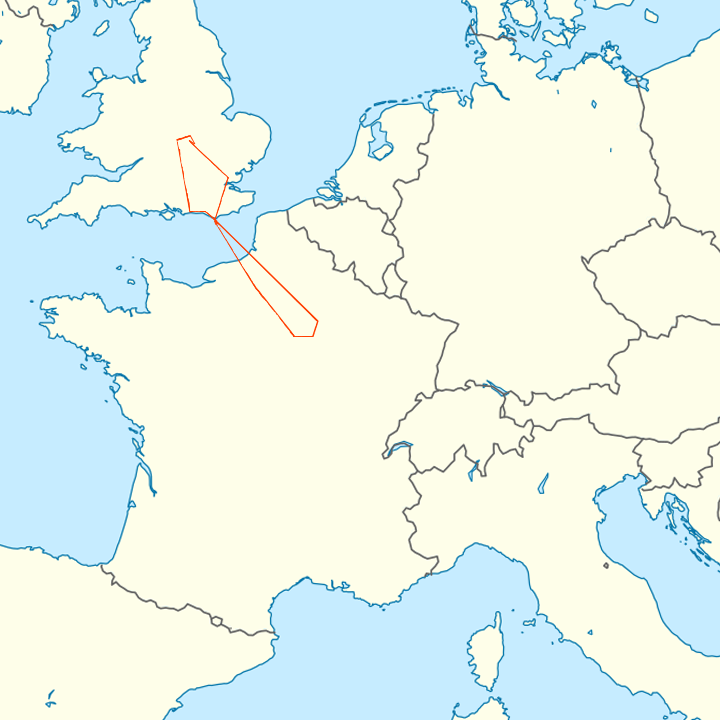
The 384BG’s strike route for 31 August 1943. The target was bombed at an altitude of 24,000 ft. Average temperature was -24 degrees.
All times PM.
| Start Engines: | 3:05 |
| Taxi: | 3:20 |
| Takeoff: | 3:35 |
| Feet Wet: | 5:12 |
| Feet Dry: | 5:28 |
| Feet Wet: | 5:58 |
| Feet Dry: | 6:18 |
| Home: | 7:04 |
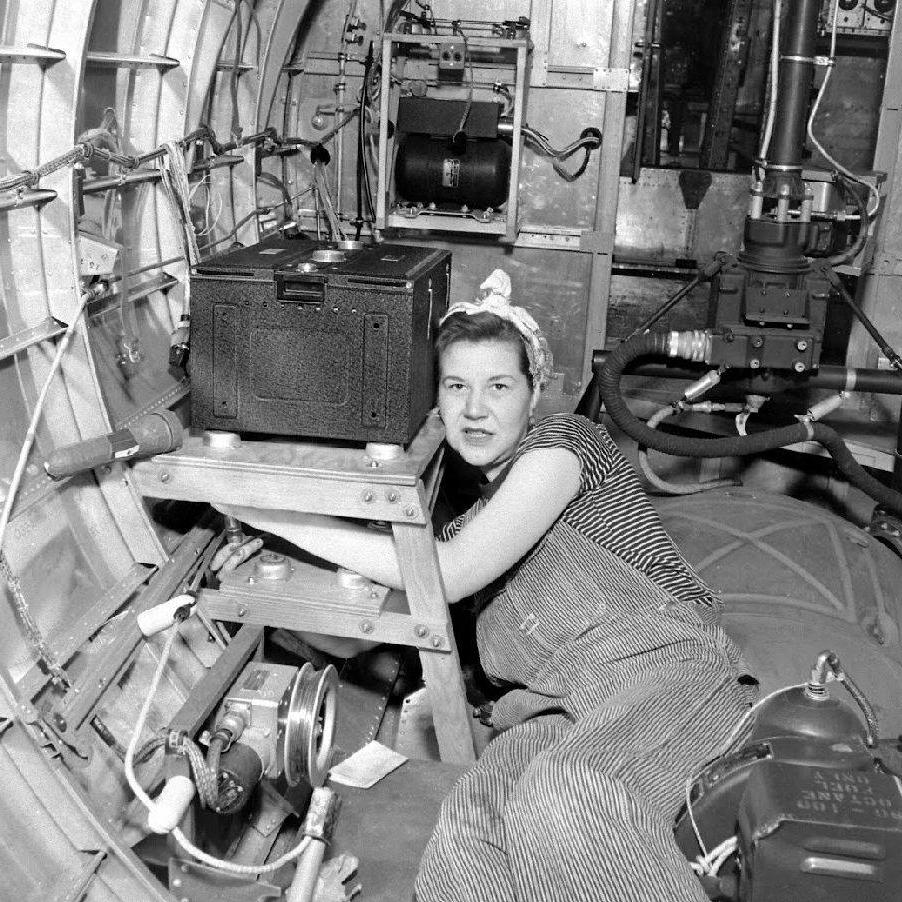
A worker at the United Airlines Modification Center in Cheyenne, Wyoming tightens the screws which mount the BC-602 Control Box for the SCR-522 VHF radio.
The VHF radio, with its large mast sticking up out of the tail, was not originally designed as a part of the B-17. As such, B-17s had to be modified by installing wooden shelves in the waist compartment. The upper shelf holds the radio while the second shelf, which is still empty here, will later hold the dynamotor power supply.
A British innovation, the SCR-522 had a frequency range of 100-156 MC and was a line-of-sight system, meaning it could only talk to another radio within visual distance.

BG William M. Gross (second from the left) attends a medal ceremony with the 381BG on 20 February 1945.
Gross’s quick-thinking on 31 August 1943 was a boon to his career, being promoted to CG 1BW on 17 September 1943 – a position he held for the rest of the war. Communicating weather reports between bombers quickly became standard procedure on US 8AF strikes. Gross later implemented other organizational improvements, such as color coding the various bomb wings and abolishing Fighter Command so that each fighter wing was permanently tied to a bomb division.
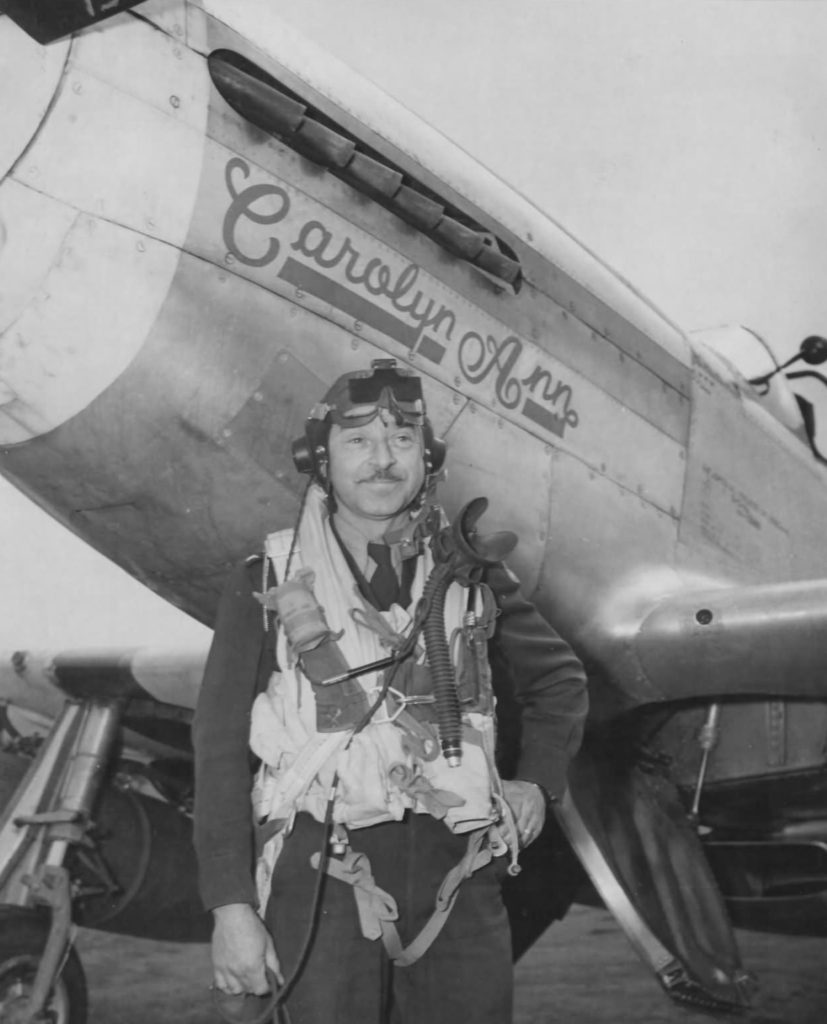
Former CO 384BG COL Budd J. Peaslee worked with Gross to take his communications concept a step further in late-1943. Peaslee proposed that bomber pilots who completed their tours be given the opportunity to become fighter pilots. These transfers would be called “Scouting Forces” and one such force would be tied to each air division, sortieing with existing fighter groups for training and protection. Similar to the RAF’s Master Bomber program, Scouting Forces worked by flying the planned route ahead of the bomber stream, checking on weather patterns and enemy opposition, and providing critical feedback to the following bomber formations. By doing so, Scouting Forces could call for course corrections and changes in target selection, with preference given to those targets with the clearest visibility.
At first, CG USSTAF GEN Carl A. Spaatz resisted this, as CG USAAF GA Henry H. Arnold issued an order on 1 November 1943 prohibiting further weather recalls, demanding that strikes follow radar-equipped Pathfinders in poor weather. However, radar accuracy was poor and an incident in February 1944 where his personal aircraft was forced to land a field due to bad weather convinced Spaatz of the wisdom of Scouting Forces.
The new Scouting Forces proved to be a major success and remained in use for the rest of the war.
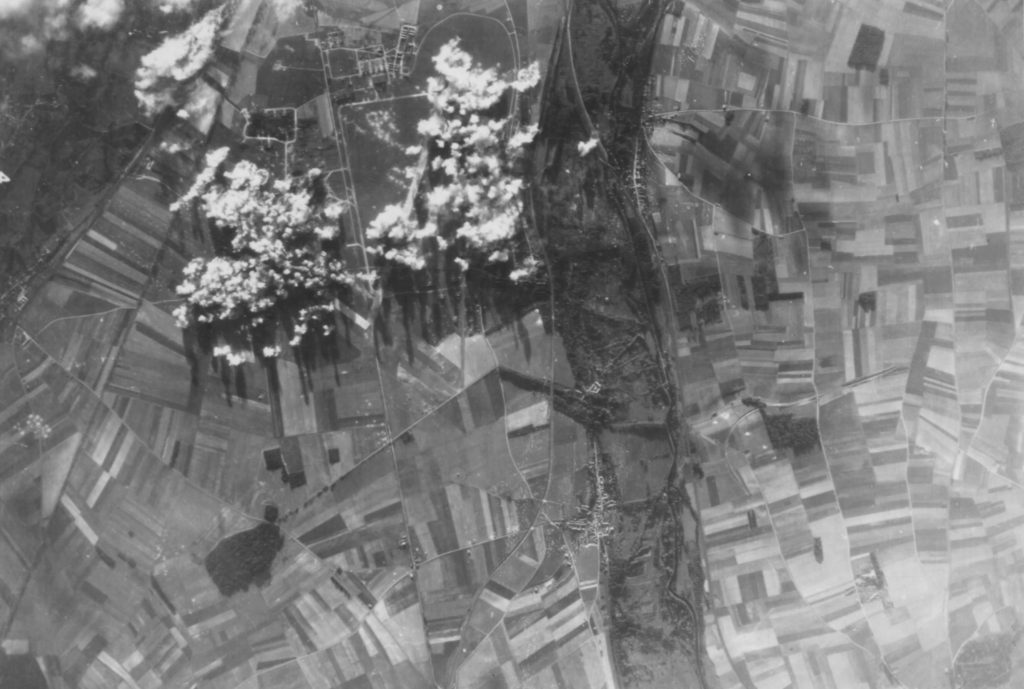
A strike photo taken on 31 August 1943 over the Amiens-Glisy airfield.
The B-17’s strike camera was mounted under the floor in the radio compartment. While Lucky Thirteen did not bomb the target this day, she did carry a Fairchild K-17 strike camera.

The Amiens-Glisy Aerodrome as it appears today, facing north. Note the forest just above the aerodrome, which is also visible in the 1943 photo.
The city to the northwest is Amiens itself.

